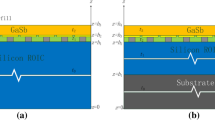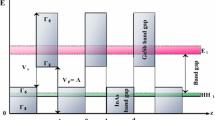Abstract
The band edge energy and effective mass of type II superlattices on a (0 0 1) GaSb substrate at different temperatures have been investigated using the empirical sp3s∗ tight-binding method. The band gap of InAs/GaSb superlattices and InAs/GaSb/AlSb/GaSb M-structure as a function of temperature is fitted using empirical Varshni’s equation. The effective mass as a function of temperature was also calculated by employing the numerical second derivative of the band energy dispersion curve. Based on the above calculation model, the analytical and numerical model of P–π–M–N device structure of superlattices model as an example was established to describe the dependence of band structure on the working temperature, which will provide guidance to achieve the higher performance.




Similar content being viewed by others
References
M. Razeghi, A. Haddadi, A.M. Hoang, G. Chen, S. Bogdanov, S.R. Darvish, F. Callewaert, P.R. Bijjam, R. McClintock, Antimonide-based Type II superlattices: a superior candidate for the third generation of infrared imaging systems. J. Electron. Mater. 43, 2802–2807 (2014). https://doi.org/10.1007/s11664-014-3080-y
M. Razeghi, A. Dehzangi, J. Li, Review of multi-band short-wavelength, mid-wavelength long-wavelength type-II superlattice based infrared photodetector. (2020). https://doi.org/10.13140/RG.2.2.31911.78240
D.Z. Ting, A. Soibel, S.A. Keo, S.B. Rafol, J.M. Mumolo, J.K. Liu, C.J. Hill, A. Khoshakhlagh, L. Hoglund, E.M. Luong, S.D. Gunapala, Development of quantum well, quantum dot, and type II superlattice infrared photodetectors. J. Appl. Remote Sens. 8, 084998 (2014). https://doi.org/10.1117/1.JRS.8.084998
Y.N. Du, Y. Xu, G.-F. Song, Theoretical analysis on the energy band properties of N- and M-structure type-II superlattices. Superlattices and Microstructures. 145, 106590 (2020). https://doi.org/10.1016/j.spmi.2020.106590
E.H. Aifer, J.G. Tischler, J.H. Warner, I. Vurgaftman, W.W. Bewley, J.R. Meyer, J.C. Kim, L.J. Whitman, W-structured type-II superlattice long-wave infrared photodiodes with high quantum efficiency. Appl. Phys. Lett. 89, 053519 (2006). https://doi.org/10.1063/1.2335509
L.W. Wang, S.H. Wei, T. Mattila, A. Zunger, I. Vurgaftman, J. Meyer, Multiband coupling and electronic structure of (InAs)n/(GaSb)n superlattices. Phys. Rev. B. 60, 5590 (1999). https://doi.org/10.1103/PhysRevB.60.5590
P.C. Klipstein, Y. Livneh, O. Klin, S. Grossman, N. Snapi, A. Glozman, E. Weiss, A k·p model of InAs/GaSb type II superlattice infrared detectors. Infrared Phys. Technol. 59, 53–59 (2013). https://doi.org/10.1016/j.infrared.2012.12.009
B.-M. Nguyen, M. Razeghi, V. Nathan, G.J. Brown, Type-II “M” structure photodiodes: an alternative material design for mid-wave to long wavelength infrared regimes. Proc. SPIE. 6479, 64790S (2007). https://doi.org/10.1117/12.711588
T. Kato, S. Souma, sp3s∗ tight-binding calculation of band edges and effective masses of InAs/GaSb superlattices with different interface structures. Superlattices Microstruct. 122, 492–500 (2018). https://doi.org/10.1016/j.spmi.2018.06.060
X.L. Zhang, L.F. Liu, W.M. Liu, Quantum anomalous hall effect and tunable topological states in 3d transition metals doped silicene. Sci. Rep. 3, 2908 (2013). https://doi.org/10.1038/srep02908
S.M. Nejad, N.R. Sheshkelani, The modeling of a SWIR type-II InAs/AlSb superlattice using an ETBM and interface. Superlattices Microstruct. 143, 106523 (2020). https://doi.org/10.1016/j.spmi.2020.106523
R. Magri, A. Zunger, Effects of interfacial atomic segregation and intermixing on the electronic properties of InAs/GaSb superlattices. Phys. Rev. B. 65, 165302 (2002). https://doi.org/10.1103/PhysRevB.65.165302
P. Piquini, A. Zunger, R. Magri, Pseudopotential calculations of band gaps and band edges of short-period (InAs)n/(GaSb)m superlattices with different substrates, layer orientations, and interfacial bonds. Phys. Rev. B. 77, 115314 (2008). https://doi.org/10.1103/PhysRevB.77.115314
R. Alchaar, J.B. Rodriguez, L. Höglund, S. Naureen, P. Christol, Characterization of an InAs/GaSb type-II superlattice barrier photodetector operatingin the LWIR domain. AIP Adv. 9, 055012 (2019). https://doi.org/10.1063/1.5094703
E. Gomóka, O. Markowska, M. Kopytko, A. Kowalewski, S. Krishna, Mid-wave InAs/GaSb superlattice barrier infrared detectors with nBnN and pBnN design. Bull. Pol. Acad. Sci. (2018). https://doi.org/10.24425/123438
C. Cervera, I. Ribet-Mohamed, R. Taalat, J.P. Perez, P. Christol, J.B. Rodriguez, Dark current and noise measurements of an InAs/GaSb superlattice photodiode operating in the midwave infrared domain. J. Electron. Mater. 41, 2714–2718 (2012). https://doi.org/10.1007/s11664-012-2035-4
I. Vurgaftman, J.R. Meyer, L.R. Ram-Mohan, Band parameters for III–V compound semiconductors and their alloys. J. Appl. Phys. 11, 5815–5875 (2001). https://doi.org/10.1063/1.1368156
E.B. Elkenany, Theoretical investigations of electronic, optical and mechanical properties for GaSb and AlSb semiconductors under the influence of temperature. Spectrochim. Acta Part A Mol. Biomol. Spectrosc. 150, 15–20 (2015). https://doi.org/10.1016/j.saa.2015.05.033
Y.A. Burenkov, S.Y. Davydov, S.P. Nikanorov, Elastic properties of indium arsenide. Sov. Phys. Solid State. 17, 1446–1447 (1975)
L.J. Slutsky, C.W. Garland, Elastic constants of indium antimonide from 4.2 K to 300 K. Phys. Rev. 113, 167–169 (1959). https://doi.org/10.1103/PhysRev.113.167
Yu.A. Burenkov, Yu.M. Burdukov, SYu. Davidov, S.P. Nikanorov, Temperature dependences of the elastic constants of gallium arsenide. Sov. Phys. Solid State. 15, 1175–1177 (1973)
Y.P. Varshni, Temperature dependence of the energy gap in semiconductors. Physica. 34, 149–154 (1967). https://doi.org/10.1016/0031-8914(67)90062-6
A. Sawamura, J. Otsuka, T. Kato, T. Kotani, Nearest-neighbor sp3s* tight-binding parameters based on the hybrid quasi-particle self-consistent GW method verified by modeling of type-II superlattices. J. Appl. Phys. 121, 235704 (2017). https://doi.org/10.1063/1.4986658
M. Xiong, Research on superlattice epitaxy and surface structure of antimonide-based semiconductors (Harbin Institute of Technology, Harbin, 2010)
A. Sawamura, J. Otsuka, T. Kato, T. Kotani, S. Souma, Nearest-neighbor sp3d5s∗ tight-binding parameters based on the hybrid quasi-particle self-consistent GW method verified by modeling of type-II superlattices. Opt. Mater. Express. 8, 1569–1584 (2018). https://doi.org/10.1364/OME.8.001569
G. Klimeck, R.C. Bowen, T.B. Boykin, T.A. Cwik, sp3s∗ Tightbinding parameters for transport simulations in compound semiconductors. Superlattices Microstruct. 27, 519–524 (2000). https://doi.org/10.1006/spmi.2000.0862
A. Boutramine, A. Nafidi, D. Barkissy, A. Hannour, A. Elanique, T. El Gouti, Application of the transition semiconductor to semimetal in type II nanostructure superlattice for mid-infrared optoelectronic devices. Appl. Phys. A 122, 1–6 (2016). https://doi.org/10.1007/s00339-016-9911-3
P. Martyniuk, J. Wrobel, E. Plis, P. Madejczyk, W. Gawron, A. Kowalewski, S. Krishna, A. Rogalski, Modeling of midwavelength infrared InAs/GaSb type II superlattice detectors. Opt. Eng. 52, 061307 (2013). https://doi.org/10.1117/1.OE.52.6.061307
J. Nguyen, D.Z. Ting, C.J. Hill, A. Soibel, S.A. Keo, S.D. Gunapala, Dark current analysis of InAs/GaSb superlattices at low temperatures. Infrared Phys. Technol. 52, 317–321 (2009). https://doi.org/10.1016/j.infrared.2009.05.022
Author information
Authors and Affiliations
Corresponding author
Additional information
Publisher's Note
Springer Nature remains neutral with regard to jurisdictional claims in published maps and institutional affiliations.
Rights and permissions
About this article
Cite this article
Zhu, X., Jie, W., Lyu, Y. et al. Modeling of temperature effects on band structure in type-II superlattices using an empirical tight-binding method. Appl. Phys. A 128, 599 (2022). https://doi.org/10.1007/s00339-022-05740-5
Received:
Accepted:
Published:
DOI: https://doi.org/10.1007/s00339-022-05740-5




